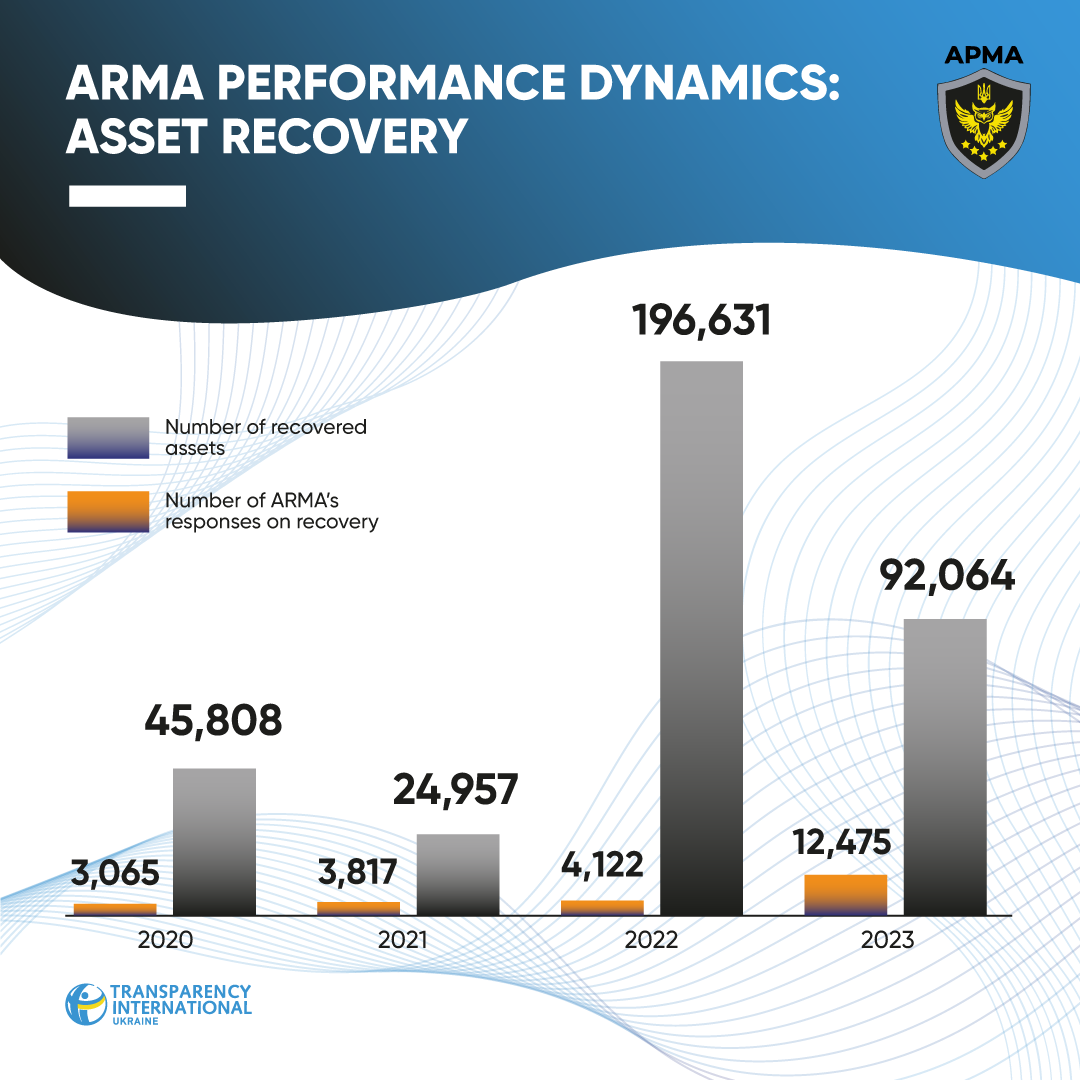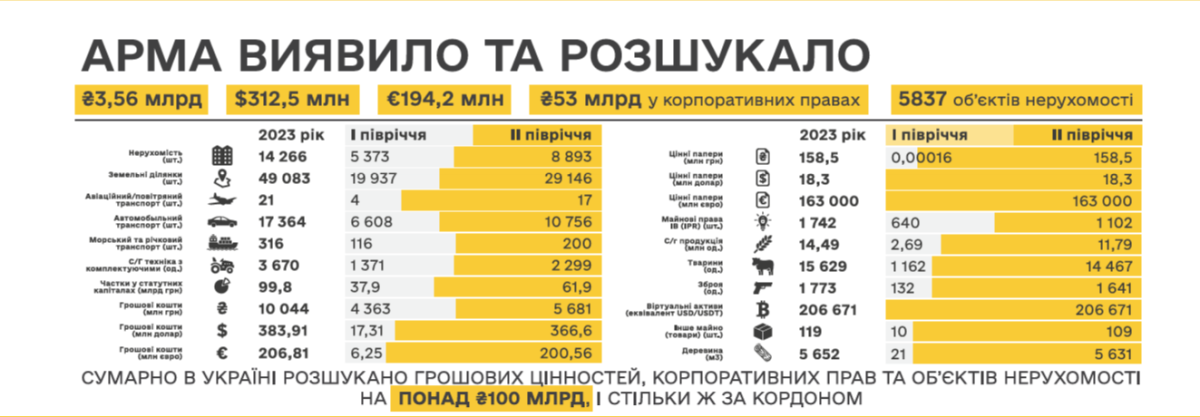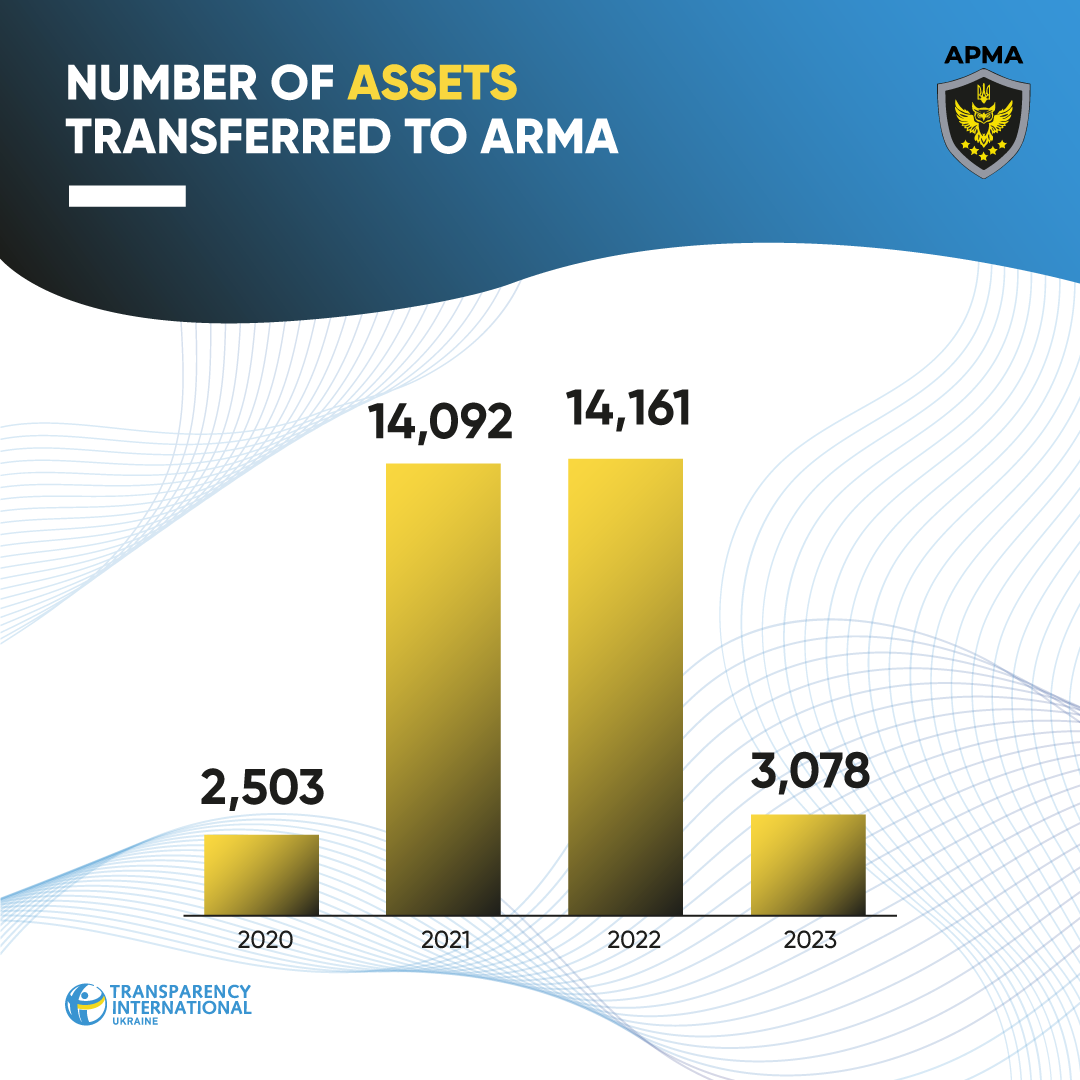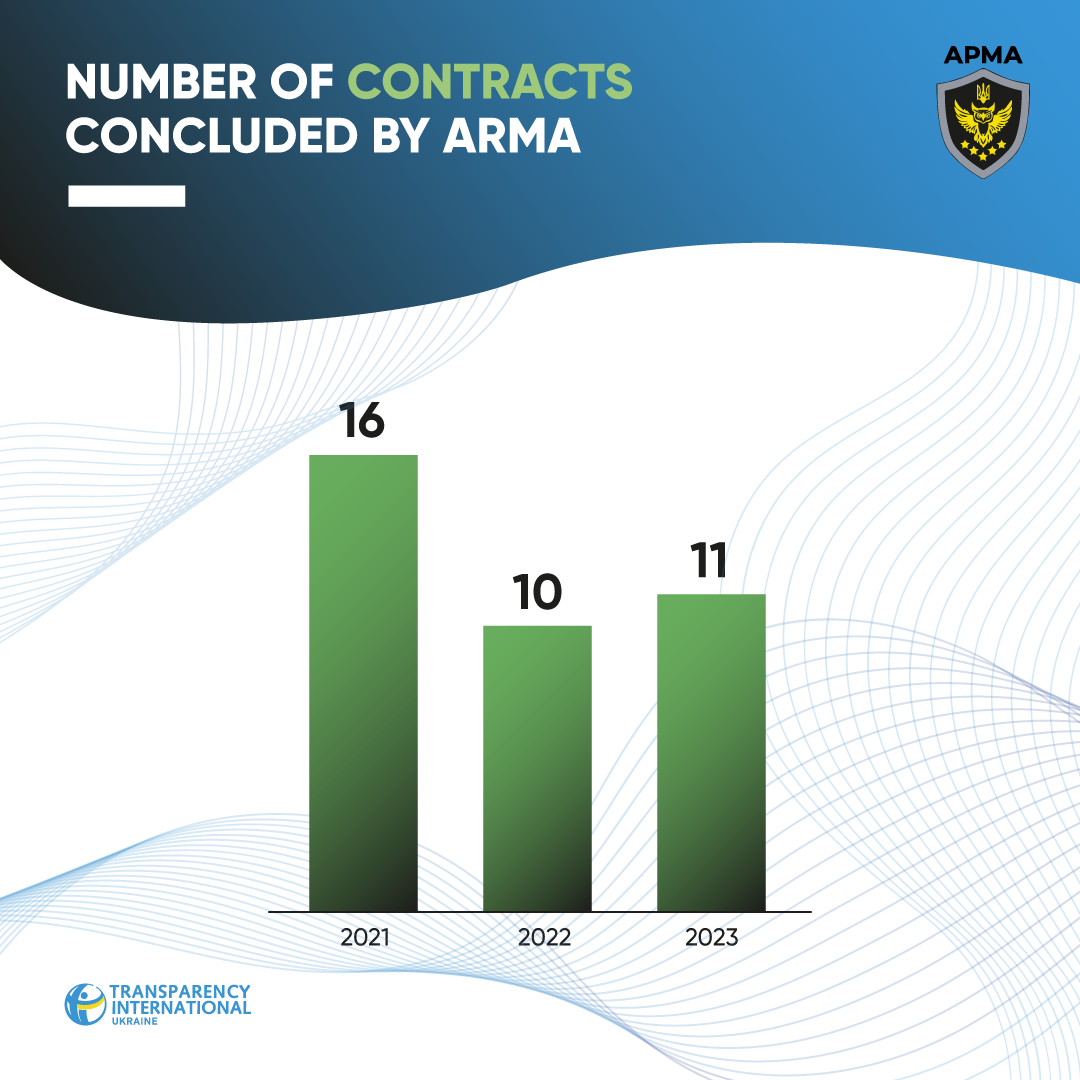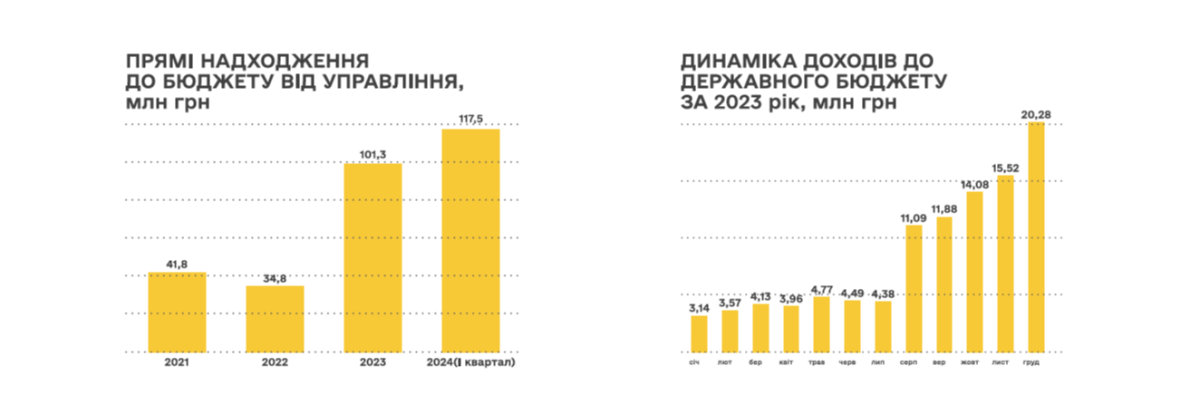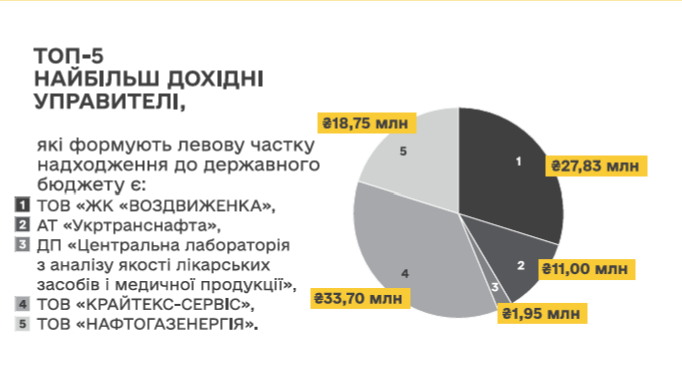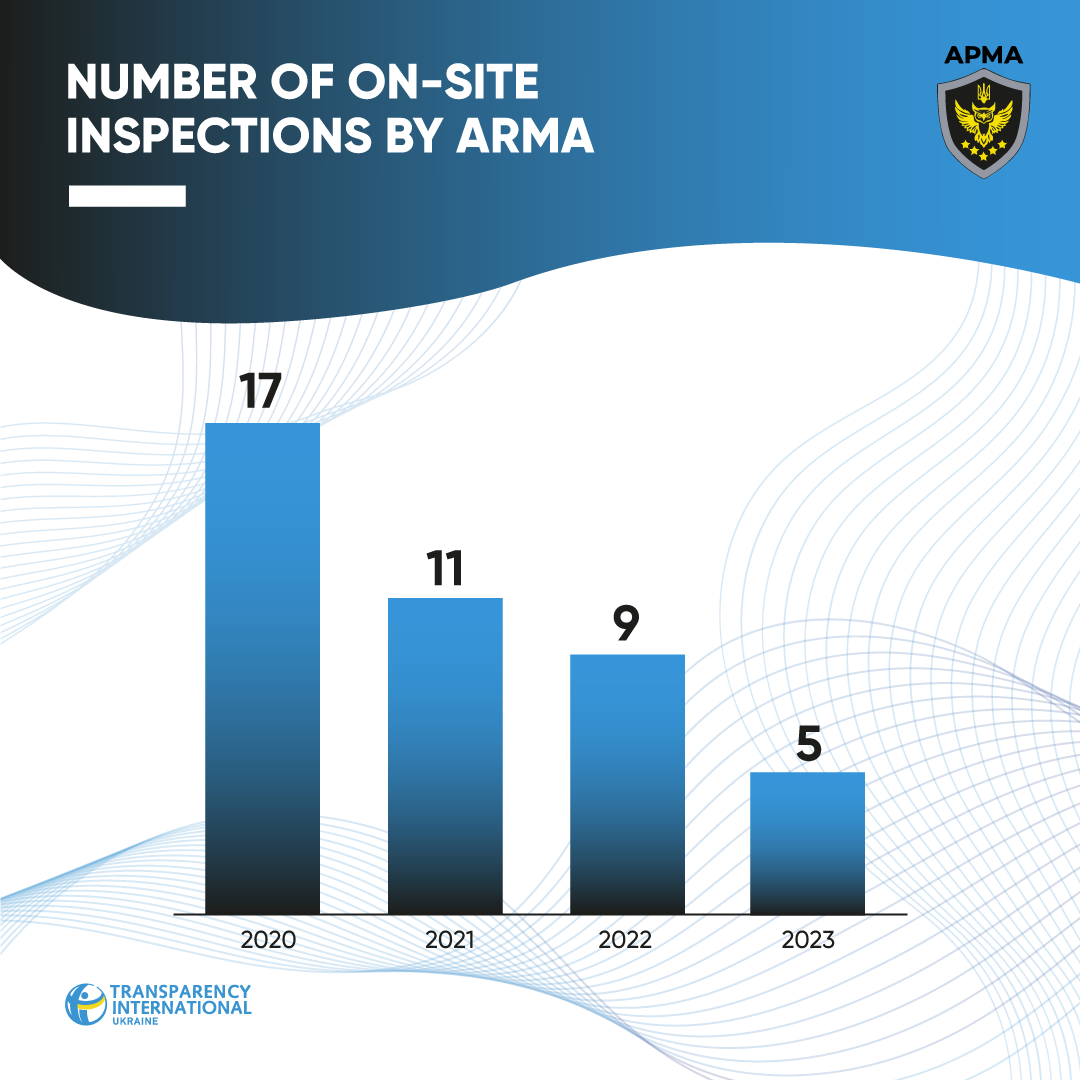

On March 26, Olena Duma reported on the results of the operation of the ARMA for the first time, covering the achievements of the body in 2023.
What haven’t we seen in the Report?
Despite all the changes that the ARMA experienced in 2023, we see that the key areas of the Agency’s work — the search for and management of seized assets — still show no progress. It is sad because this is what the ARMA was created for.
Here are the statistics from the reports on the effectiveness of the budget program for different years.
Last year, we observed a significant decrease in the number of recovered and searched assets compared to 2022. In 2020, 45,808 such assets were recovered by the ARMA; in 2021, this figure was 24,957; in 2022 — 196,631; and in 2023, half as many — 92,064. It was last year that the Agency provided many responses regarding the recovery of assets, but the volume of property decreased.
Presenting the report for 2023, the ARMA contrasts the figures for the first and second half of the year, demonstrating the statement that the effectiveness of asset recovery is increasing. After all, Ms. Duma was appointed at the end of the first half of the year, so this approach is not particularly surprising. The Agency also considers the increase in the number of requests for asset recovery to be a record achievement.
Screenshot from the presentation “Results of ARMA’s activities for 2023”
Of course, at first, such figures might be impressive, but having studied the topic in more detail, we saw not so much the real state of affairs as the ability of the current leadership of the ARMA to adjust the statistics and present them from a favorable angle. If we compare the data by years, the situation for Ms. Duma will not be so pleasant.
Despite all the changes that the ARMA experienced in 2023, we see that the key areas of the Agency's work — the search for and management of seized assets — still show no progress. It is sad because this is what the ARMA was created for.
Pavlo Demchuk
By the way, the number of assets transferred to the management of the ARMA (3,078 in 2023) also decreased sharply compared to 2021 (14,092) and 2022 (14,161). Now it is only slightly higher than in 2020 (2,530). This indicator is influenced by both the number of cases where there are grounds for transferring assets to the ARMA and the trust in the Agency. If an investigator believes that after the transfer of the property it will be embezzled or that the asset will be damaged or lost at all, they will not apply to an investigating judge with a corresponding motion.
Despite the extremely high number of seized assets transferred to the ARMA in 2022, the situation with the number of management contracts concluded has not changed much. In 2021, the Agency concluded 16 agreements, in 2022 — 10, and in 2023 — 11.
Unfortunately, in the report for 2023, the ARMA did not explain the negative trends or provide clarifications on how to solve such negative dynamics. But it provided information about extremely high revenues to the national budget of Ukraine.
Let us remind you that the ARMA is not a fiscal authority. Its primary task is to manage seized assets effectively, and given the number of management contracts concluded, this function is far from ideal. The seized assets are idle and are losing their value, and their owners receive additional reasons to file lawsuits for damages.
Screenshot from the presentation “Results of ARMA’s activities for 2023”
In the presentation to the performance report, the ARMA also mentions the most profitable managers. Among them are LLC Residential Complex VOZDVYZHENKA (management contract concluded in 2018), JSC UKRTRANSNAFTA (2021), SE Central Laboratory for Drugs Quality Analysis and Medical Products (2022), LLC KRAITEKS-SERVICE (April 2023), and LLC Naftogazenergia (April 2023). As we can see, all these managers operated before Olena Duma assumed the position of ARMA head, but there have been no successful managers during her tenure.
At the same time, control over the effectiveness of management contracts is only decreasing. For example, there were almost half as many on-site inspections last year as in 2022.
It is an on-site inspection that allows checking the availability and condition of assets and carrying out their photo or video recording, and not only to assessing the effectiveness of management by analyzing documentation. The total number of inspections conducted is rapidly decreasing, from 17 in 2020 to 5 in 2023.
Despite the extremely high number of seized assets transferred to the ARMA in 2022, the situation with the number of management contracts concluded has not changed much. In 2021, the Agency concluded 16 agreements, in 2022 — 10, and in 2023 — 11.
Pavlo Demchuk
***
All this indicates once again that the Agency’s performance of its core functions leaves much to be desired. Nowadays, the leadership of the ARMA shows its achievements mainly through the direction of money management.
If the sale of the seized property was “fixed” by the efforts of many partners, then the transfer of assets to the ARMA’s management still has many deficiencies. Unfortunately, all attempts to use public procurement legislation for this will not rectify the existing problems with the selection of managers for seized assets. The nature of such property and its status require significantly different approaches, and both we at TI Ukraine and the Agency know them, having often covered this information publicly. However, it is likely that the current leadership of the ARMA finds their implementation much more complicated than focusing on regulatory documents from other areas.
The management of immovable and movable property subsides quite significantly, although by law this should be one of the main tasks of the Agency. To make the sphere more successful, it is necessary to establish a transparent and business-friendly procedure for selecting a manager of seized assets to ensure the rapid implementation of such procedures. Then both the state and the owners of assets to whom this property can potentially be returned will be satisfied.
However, currently, we see that the ARMA management focuses mainly on simple and quick results that do not really correspond to the main functionality of the body. The annual report presented by the Agency only confirms this pessimistic statement.
Currently, we see that the ARMA management focuses mainly on simple and quick results that do not really correspond to the main functionality of the body. The annual report presented by the Agency only confirms this pessimistic statement.
Pavlo Demchuk




